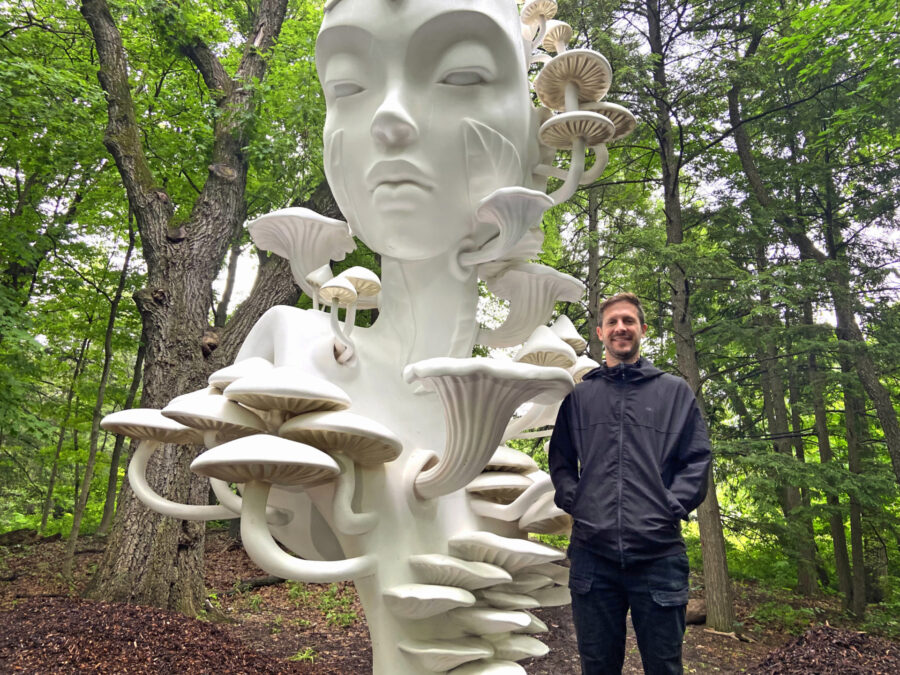Daniel Popper is a multidisciplinary artist who is transforming the landscape of public art by blending human experience with the natural world. His work, which can be found in public spaces and at festivals, aims to democratize art and challenge the elitism often associated with traditional galleries. By placing his large-scale, interactive sculptures in these settings, Popper engages a broader, more inclusive public. This approach positions him as a pioneer of “experiential art,” where the viewer’s physical and emotional participation is central to the work. The success of his art is measured not by commercial transactions, but by the level of public engagement and its emotional and social impact.
Popper’s art promotes ecological consciousness and community engagement in a time of growing digital disconnection. His installations, such as LUMEN in Miami and his contributions to the Freedom Monument Sculpture Park in Alabama, demonstrate his thematic depth and contemporary relevance. These projects show his dedication to creating art that is both visually stunning and meaningful, turning public spaces into sites for contemplation and connection.
Historical and Contextual Background
Born in Johannesburg, South Africa, in 1983, Daniel Popper’s artistic journey began with a formal education in classical fine art. He earned a Bachelor of Fine Arts in Oil Painting from the Michaelis School of Fine Art in Cape Town in 2006. His early work was influenced by South African artist William Kentridge, exposing him to socially conscious and multidisciplinary practices.
A significant turning point in Popper’s career came in 2007 when he created his first giant puppet for the AfrikaBurn art festival. This experience shifted his focus from the traditional gallery setting to creating interactive installations that “us[e] the environment, space and people”. This early success led to major commissions, including 14 “Pop Puppets” for MTN at the 2010 FIFA World Cup, which demonstrated his ability to combine art with large-scale public engagement and brand activation.
Popper intentionally moved away from the traditional art scene, stating that it offered “less noise and less history to compete with” and provided a new way of thinking about scale and space. His early projects, such as the “Hand Of God” at AfrikaBurn and a 15-meter Baobab tree for Siemens at the COP17 climate conference, showcased his commitment to monumental scale and environmentally conscious themes. Attending the Burning Man festival in 2011 further immersed him in the culture of large-scale, temporary, and interactive art, solidifying his signature approach. This period established the groundwork for his later work, which explores the human-nature relationship and profound spiritual themes. His rejection of the traditional gallery system was a deliberate choice to prioritize impact and reach over conventional art world validation.
This transition also allowed him to develop a sustainable business model. Early collaborations with brands like MTN and Siemens provided the financial and logistical support needed for his ambitious projects, creating a self-sustaining ecosystem separate from traditional fine art funding.
Current Landscape and Thematic Focus
Daniel Popper is known for his monumental sculptures that blend the organic spirit of nature with the essence of the divine. His large-scale figures, often human forms, are crafted from materials like wood, fiberglass, steel, and concrete, transforming public spaces into immersive environments. His art consistently features an ecological aesthetic, emphasizing harmony with nature. Recurring themes include the symbiotic relationship between humanity and nature, interconnectedness, resilience, and community. Many of his works are designed for interaction, allowing viewers to walk through them, or they feature dynamic projection mapping to enhance their mystical quality.
The scale of his projects requires a highly collaborative studio model, with a team of specialists in installation, construction, design, and engineering. The studio uses advanced digital tools like 3D software (ZBrush, Maya, Rhino 3D) and fabrication techniques such as 3D printing and CNC routing. This multidisciplinary approach, which includes collaboration with experts in electronic music and lighting, is essential for creating his characteristic immersive, sensory experiences.
Popper’s recent work includes a significant number of permanent installations and major exhibitions. The “Human + Nature Exhibition” at the Morton Arboretum in Illinois (2021-2023) was his largest to date, featuring sculptures up to 26 feet tall. The exhibition’s popularity led to its extension, and one of the sculptures, Heartwood, was later relocated to Chicago’s Museum Campus.
In 2024, Popper unveiled LUMEN, a 30-foot permanent sculpture in Miami, which uses mosaic tiles and projection mapping to explore the connection between people and nature. Two of his monumental sculptures, Hallow and Heartwood, were permanently installed at the Equal Justice Initiative’s Freedom Monument Sculpture Park in Alabama. These works, which honor enslaved people, signify a deeper engagement with socio-historical narratives. Popper’s contribution to this park alongside artists like Simone Leigh and Kehinde Wiley marks a pivotal engagement with profound social narratives.
Popper has also developed a successful commercial model through his production company, “Pop Productions,” which offers services in creative design and brand activation. His collaborations with brands like MTN and Siemens and engagements at major events show a savvy understanding of the economic landscape of public art. Public art can boost local economies, with studies showing it can increase foot traffic by up to 30% and generate a significant return on investment. This commercial success allows him to fund ambitious projects that would be difficult to finance through traditional art patronage.
Critical Perspectives and Future Direction
Popper’s work is often described as “surreal,” “shamanistic,” and “awe-inspiring”. The scale and visual impact of his sculptures draw widespread public attention, and their contemplative nature invites introspection. While some might question if the “wow” factor overshadows deeper meaning, the consistent thematic depth and integration into significant cultural sites like the Freedom Monument Sculpture Park provide a strong counter-argument. The interactive nature of his pieces is widely praised for fostering a personal connection, moving viewers from passive observation to active participation. Popper himself hopes his art will encourage viewers to “ask questions of themselves about their relationship with nature”. The positive public reception of his work indicates a demand for art that provides solace, connection, and a sense of wonder.
A core tenet of Popper’s practice is his “ecological aesthetic,” which emphasizes harmony with the environment. He often incorporates living plants and uses natural and reclaimed materials. His works are often intended as a “call to action regarding ecological awareness and conservation”. However, the environmental impact of creating and transporting massive sculptures globally presents a nuanced ethical challenge. While he uses conscientious materials and some renewable energy, the logistics of his global operations imply a significant carbon footprint.
Popper is strategically shifting his focus towards more permanent, public installations and away from temporary festival works. This move is motivated by a desire for a greater “sense of investment” and a more enduring legacy. This trajectory is already evident in his permanent installations like LUMEN and the works at the Freedom Monument Sculpture Park. This shift suggests his art may become an integral, lasting part of urban and natural landscapes, influencing urban planning and cultural heritage for generations.
His studio’s use of advanced 3D software, 3D printing, and CNC routing, combined with his consistent use of projection mapping, positions him at the forefront of the “phygital” art movement, which blends physical and digital elements. Future works may include more sophisticated interactive elements, such as sensors that respond to environmental data or augmented reality layers. This will create dynamic, evolving artworks that offer new dimensions of engagement.
Popper’s recent engagement with socio-historical narratives at the Freedom Monument Sculpture Park suggests his art may increasingly serve as a vehicle for direct social commentary and healing. His sculptures could become focal points for dialogue on human rights and historical memory. His continued success in blurring the lines between art, sculpture, and brand activation could also legitimize and expand this hybrid commercial model, leading to more artists adopting similar business structures to fund ambitious projects.
In conclusion, Daniel Popper’s work demonstrates that art can achieve profound impact outside of traditional spaces. His monumental figures foster connection and community, blending traditional craftsmanship with cutting-edge technology to create immersive experiences. His practice offers a compelling model for sustainable and economically viable large-scale sculpture. As he continues to focus on permanent installations and deeper societal engagement, his work promises to define the role of monumental sculpture in shaping our collective consciousness.









